Denver Mid-Century Modern Landscapes
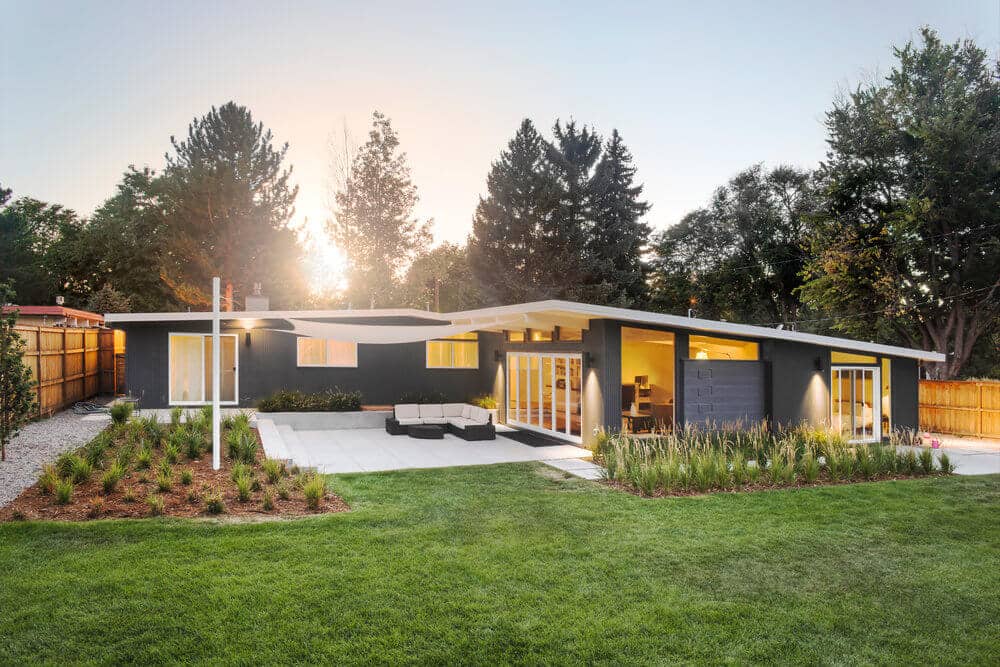
Parallel with rising homeowner trends in embracing outdoor living, the integration between interior and exterior design features is an essential aspect of mid-century modern architecture. Landscape design plays a direct role in our well-being and the idea of mid-century modern landscape design focuses on weaving indoor and outdoor motifs in ways that extend enjoyment to a home’s surrounding property.
Using a combination of natural and artificial elements, simple gardens, clean lines, muted tones, and orderly structure, the mid-century modern design movement is all about unsophisticated simplicity and unpretentious arrangement – ideas that can also apply to landscaping design. Explore principles, origins, and design ideas that bring mid-century modern landscaping to life.
What is Mid-Century Modern Landscaping?
Drawing inspiration from mid-century modern homes and interior design characteristics, the fundamentals of mid-century modern landscaping create a harmonious connection between indoor and outdoor spaces. It can be described as clean, contemporary, and functional, often combining hardscapes, plants, and water elements into a livable landscape that naturally suits the home’s architecture.
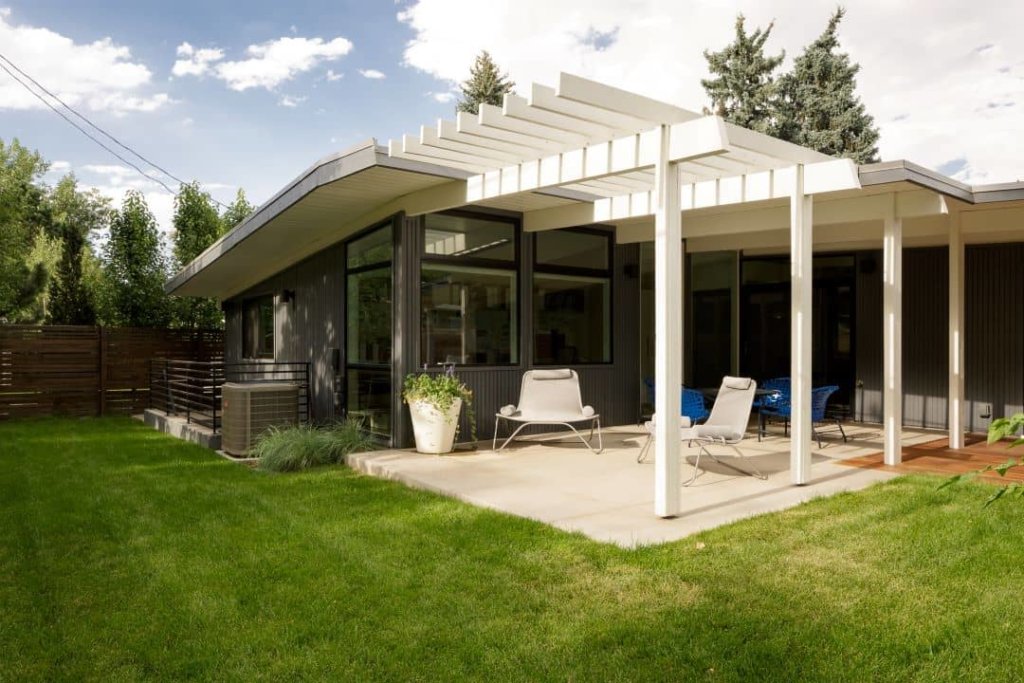
Emphasizing the integration between indoors and out, mid-century modern landscapes are designed to be lived in, not just observed. The modern homes that inspire such designs often have floor-to-ceiling windows and sliding doors that seamlessly interact with the outdoor environments like courtyard patios, botanical-rich atriums, and vibrant backyards.
History of Mid-Century Modern Design & Landscaping
Mid-century modern has European roots, stemming from the German Bauhaus design and architecture school of the pre-1940s. As part of a wider movement called mid-century modernism, this style of German architecture was viewed as having a new age-y design aesthetic that blends functionality and enjoyment with a Zen-like simplicity and cleanliness.

Mid-century modern design became prominent in America during the post-World War II years. As more Germans and Europeans moved to America after the war, they brought their design influence, ranging from furniture, home décor, interior design, home and landscape architecture.
Coined by Cara Greenberg in the 1950s to describe the style in home furniture and design context, the idea of mid-century modern was driven by several notable designers, including Ludwig Mies van der Rohe, Eero Saarinen, Isamu Noguchi, and Arne Jacobsen. The work of these icons and other influencers inspired a movement in mid-century modern architecture and landscaping that remained popular throughout the 1960s and 1970s.
Despite trends diminishing in the 1980s, there’s been a big resurgence in mid-century modern design, especially with home architecture, outdoor hardscapes, landscapes, gardens, and interiors. Today, it’s a category that takes many shapes, including linear gardens, geometric shapes, flat/single-slope roofs, mixed-material mashups, and bright accents layered on neutral tones.

Best Plants for Mid-Century Modern Landscaping
There are no limitations when it comes to the types of plants used for mid-century modern landscaping. The best outcomes are achieved when taking into consideration how certain plants fit with the home, surrounding property, and native habitat. Some of the general categories of modern landscaping plants include:
- Ground Covers: Capture the clean look of modern landscape design with lush ground covers. In Colorado, some of the best options are Clover, Lilyturf, Silver Tip Moss, Creeping Thyme, and Coral Beauty Cotoneaster.
- Shrubs & Flowers: These versatile plants add color and greenery to a landscape while shaping its curb appeal and wildlife. Great shrubs and flower options for Colorado landscapes include Spreading Juniper, Euonymus, Snowberry, Serviceberry, Golden Currant, Smooth Sumac, and Western Wild Rose.
- Ornamental Grasses: Bring texture, height, and contour to a modern landscape or a splash color with certain grasses. Native options in Colorado include Little Bluestem, Indian Ricegrass, Side-oats Grama, and Blue Grama Bouteloua.
- Cacti & Succulents: One of the most popular plants for mid-century modern landscape designs, due to their minimalist, calming nature, are succulents and cacti – they are great drought-tolerant plants that work well in the Rock Mountain region. Wonderful options include Plains Yucca, Prickly Pear, Yellow Nipple, and Pink Nipple Cactus.
- Trees: Some mid-century modern design concepts involve a focal point of one or two particular pieces of emphasis. For landscape design, trees are popular choices. This typically involves ornamental trees or native options like Amur Maple, Japanese Tree Lilac, Gambel Oak, Rocky Mountain Maple, and Juniper. These can also be great for privacy.
Learn the importance of tree maintenance and care
Lastly, mindful placement and regular care also go a long way in maintaining an outdoor ecosystem that melds beautifully with the home and property as a whole.
Mid-Century Modern Landscaping Design Ideas
Mid-century modern homes and landscapes come in many distinguished forms. The inspiration is limitless, as new and innovative modern designs continue to evolve the range of ideas imaginable. At Environmental Designs, we’ve contributed various projects in the space. Below we showcase a few of those projects to offer unique, mid-century modern landscaping ideas to inspire your outdoor design.
Seamless Extensions from Indoors to Outdoors
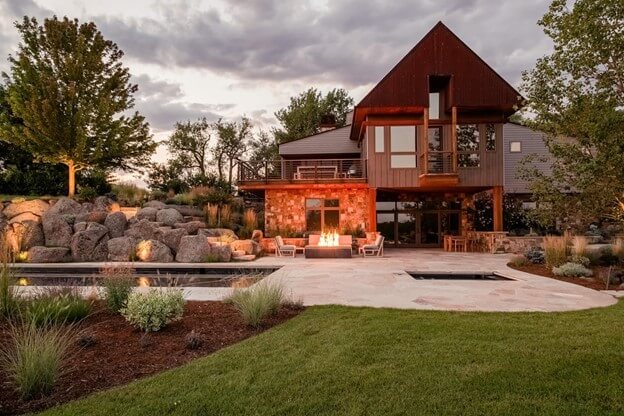
This majestic property and pool landscape captures the essence of modern design, providing a seamless extension from indoor to outdoor living. For hardscapes, a natural and functional boulder wall meets an expansive stone pool deck that gives way to a stunning view. Low-lying grasses and shrubs help complete the look in a simple manner that aligns well with a modern fire feature for gathering and surrounding lush green lawn for playing.

Minimalist Landscape & Hardscape Design for Maximalist Enjoyment
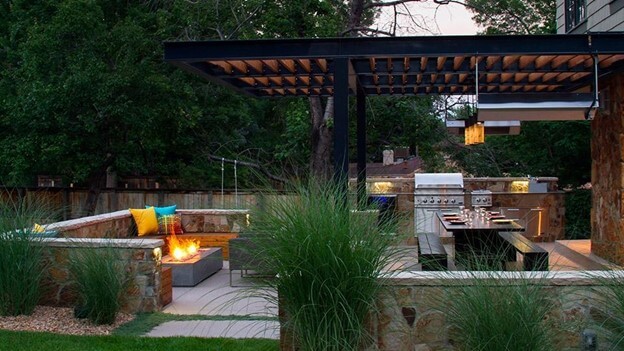
Another perfect example of an outdoor living space extended harmoniously from the house, the minimalist combination of hardscape and landscape design provides a peaceful retreat to gather and socialize. Tall grasses and surrounding flowers and shrubs bring a natural element to the stone wall and integrated wood seating. The rectangular fire element, tastefully-lit outdoor kitchen, and pergola overhang make for an inviting place to enjoy the company of family and friends.
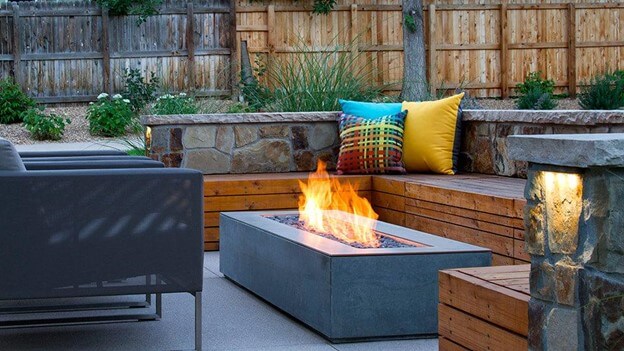
Where Mid-Century Modern Meets Botanical Retreat
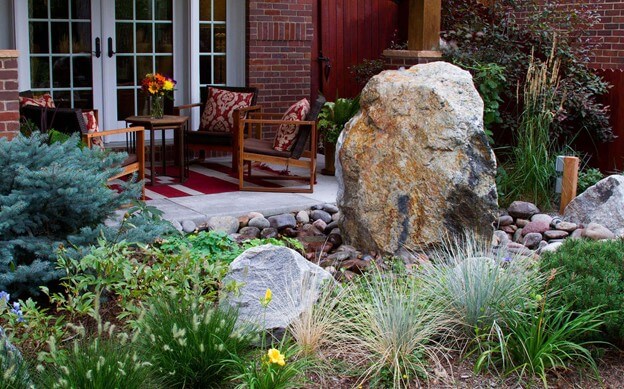
Mid-century modern design doesn’t have to compromise on natural scenery and abundant plant life, and this landscaping project is the perfect example. Truly a botanical retreat, this backyard landscape includes a variety of small evergreen trees and shrubs, ornamental grasses, and colorful flowers. The yard combines compartmentalized seating arrangements with a unique stone-immersed fire element and a small, easy-to-maintain lawn.
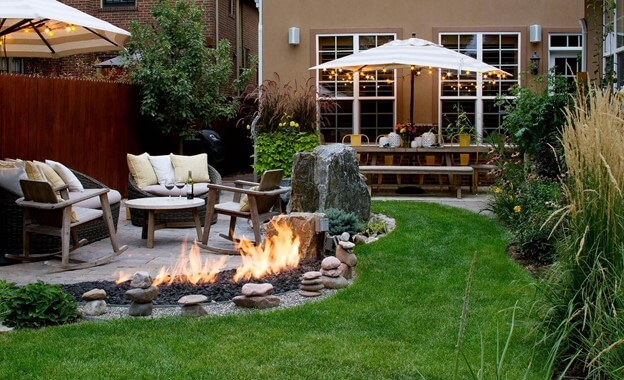
New Age Inspiration for a Mid-Century Modern Design
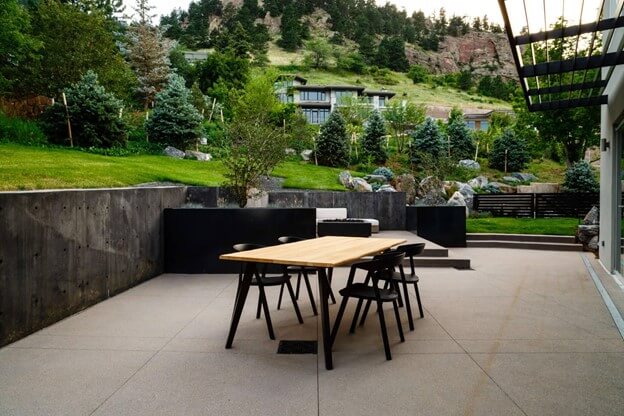
For mid-century modern architecture that blends industrial minimalism with sharp lines, muted tones, and stonework, the surrounding landscape can go a long way in adding natural appeal. Such is the case with this project where a surrounding landscape gives way to abundant greenery. Bordered with evergreens and groundcover, this project combines a naturally-sloping lawn with boulders, grasses, and a few strategically placed trees, all surrounding a modest outdoor patio space designed for dining and casual gathering.
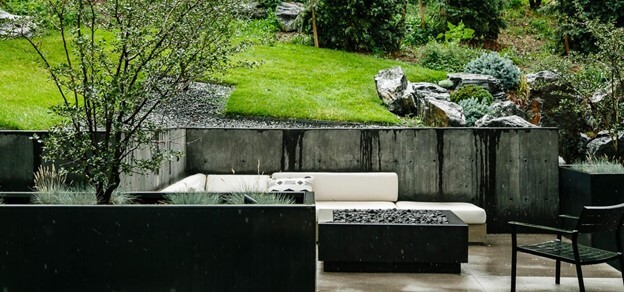
An Inviting Colorado Sanctuary
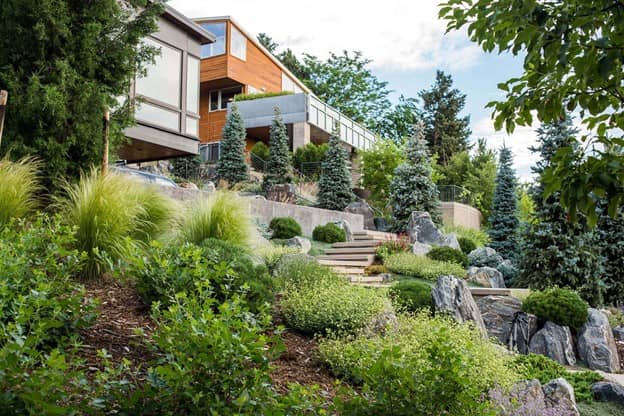
This mid-century modern landscape captures the essence of Colorado’s countryside by combining stonework and rock elements with copious greenery by way of dense shrubs and bushes, flaring grasses, and sporadically-placed evergreens. The contouring plant selection matches the sloping landscape and elevated approach, which all surrounds a concrete pathway leading up to the Rocky Mountain abode. No water or fire element is needed for this scenic Colorado sanctuary.
How to Plan a Mid-Century Modern Landscape Design?
In addition to the plants you choose, planning a modern landscape design involves a number of considerations. Whether drafting plans for a new project, redesigning an existing landscape, or simply making a few changes, consider these tips to help you actualize the mid-century modern landscape you envision.
Plan According to Your Property & Region
In Colorado, the state’s ecological zones vary widely, from steppe and foothills to coniferous forest and alpine tundra zones. Planning according to your microclimate and ecological zone, topography and water drainage, sunlight exposure, and soil type is crucial for the sustainability of your landscape and plant life. Use tools like the USDA Plant Hardiness Zone Map to assess which plants may be most appropriate.
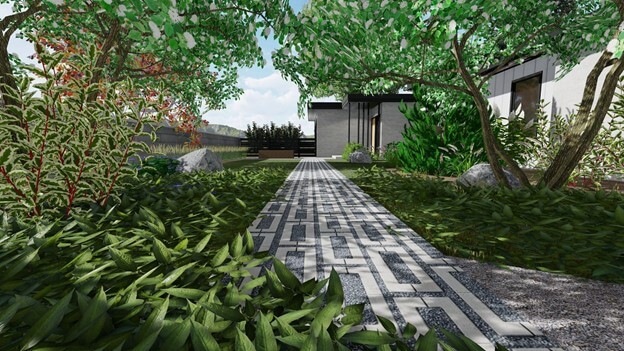
Order Your Plants from Various Perspectives
Visualize different planes by organizing and sequencing plants. In addition to planning your modern landscape design from a traditional overhead view, consider a vertical plane, such as the spacing in between plants, how they’re layered, and how they’re staggered. Also visualize the ground-level plane, such as how hardscapes and groundcovers are arranged.
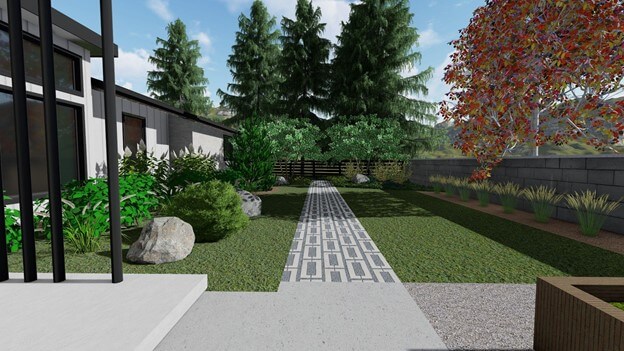
Create Cohesion Between Spaces
In the same way you’d design the architecture of your home to create a flow between rooms, you can do the same with outdoor spaces involving your landscape. This might involve back patio hardscapes with outdoor living elements, garden-lined pathways, pools and water elements, and immersive backyard landscapes that are a natural extension of the home.
Consider How Your Landscape Will Be Used
Take into consideration all of the different ways in which your mid-century modern landscape will be used. Will kids be enjoying the space? What about dogs and pets? Do you envision using your space for gathering, entertaining, relaxing, or other specific purposes? These thought-starters will help you better prioritize your design while factoring-in ongoing maintenance.
Maintain a Consistent, Modern Theme
Using a cohesive, mid-century modern theme can help unify your landscape, thereby guiding decisions around which plants and materials to use. For instance, some plants and materials might look attractive, but if they don’t fit in with the landscape’s theme, these elements might clash, either visually or functionally. Most modern landscape design themes emphasize geometric shapes, clean edges, muted tones with bright accents, and simplistic, minimalist aesthetics.

Maintaining Your Modern Landscape
An essential part of mid-century modern landscaping is maintenance. This is one area that many homeowners struggle to get right, as even low-maintenance plants require some level of care over time. From pruning, weeding, and watering, there’s often a lot of care and maintenance required to keep a landscape looking beautiful and healthy. Some of the most important maintenance considerations to keep in mind include:
- Water according to your climate and season. Dry climates often require more watering, depending on the plants.
- Trim and prune plants to prevent overgrowth and keep your landscape looking orderly.
- Ground covers and gardens require regular weeding to maintain optimal health.
- Avoid trampling on your ground covers and lawn. Partition your landscape with dedicated walkways and hardscapes to minimize damage.
- Fertilize mindfully, if at all. In the instance you do use fertilizer, try to use an organic option when available.
Of course, recruiting the help of a local landscaping company can help in maintaining your property. Here at Environmental Designs, we can help in the design, development, and maintenance of your landscaping project.

Need Help from Modern Landscape Professionals?
Many Colorado residents have asked our landscape professionals to help guide their mid-century modern landscape project in a way that flows with their mid-century home. Over the years, we collaborated with homeowners, property developers, and other hardscape professionals to bring project ideas to life. The landscape design principles we follow help us create visually pleasing and creative designs for all of our clients. Our team of Denver landscape designers and architects are experts in designing modern landscapes of all styles and sizes. If you’re ready to get started on your Denver mid-century modern landscape project, contact us today for a free quote.

